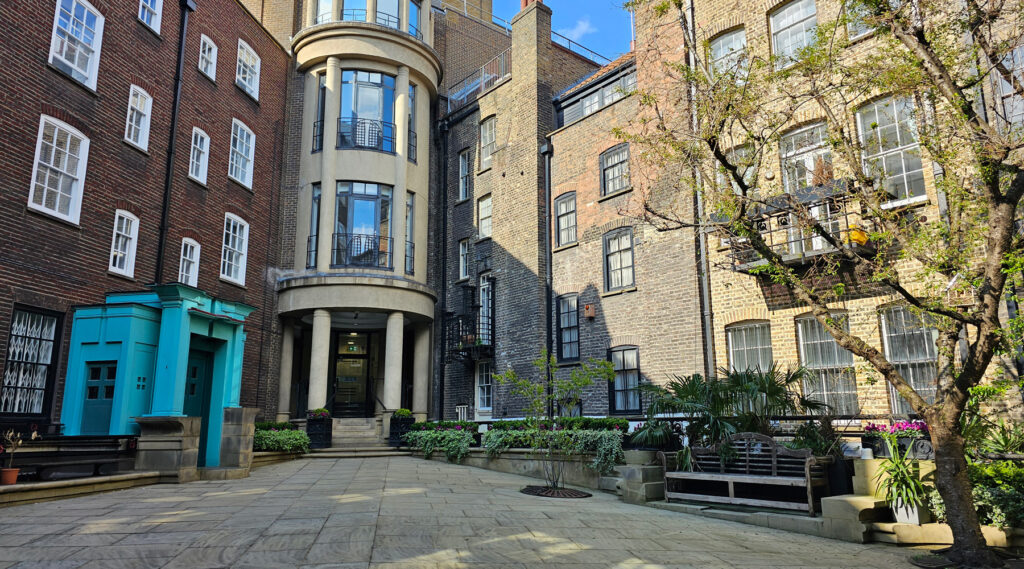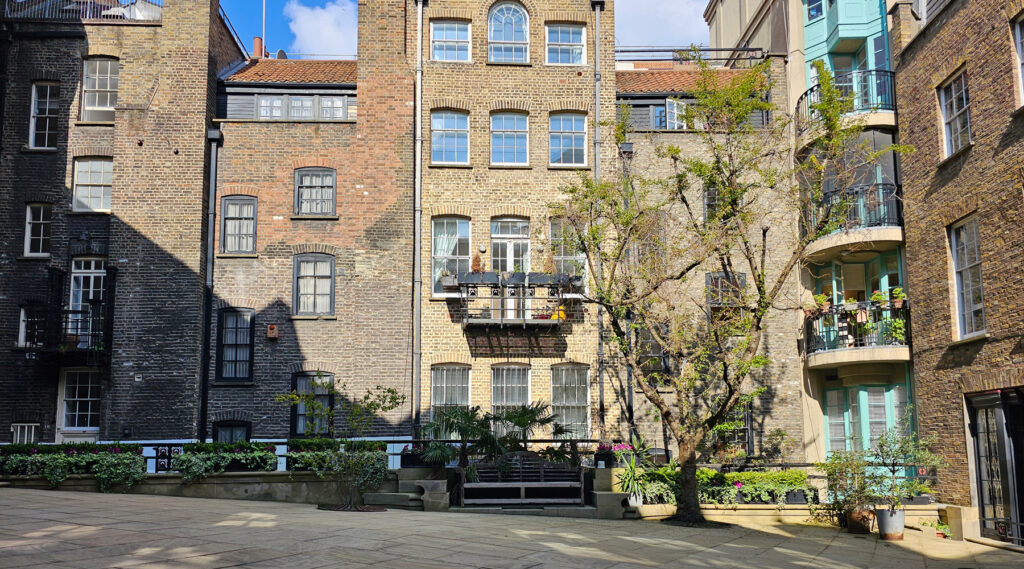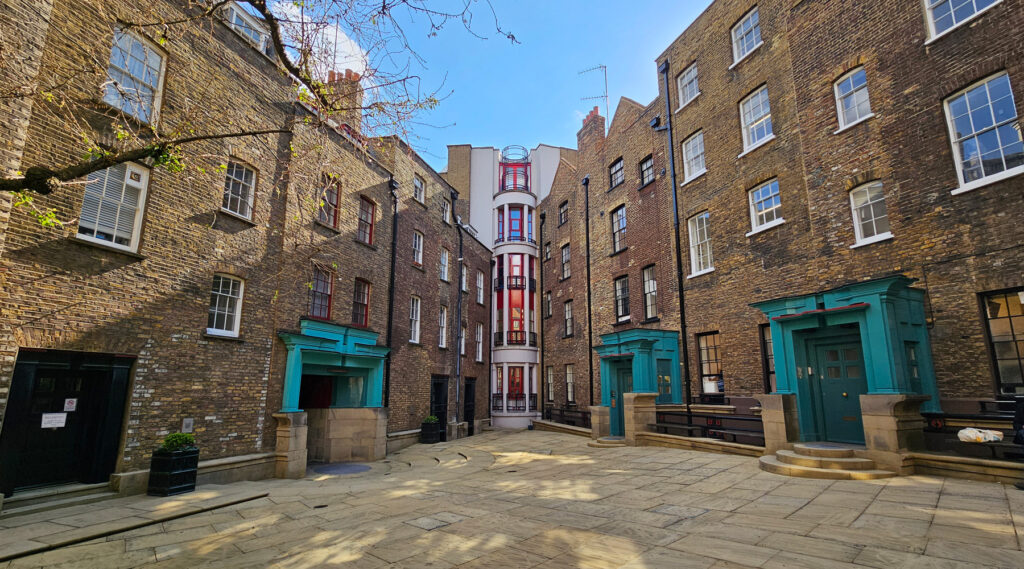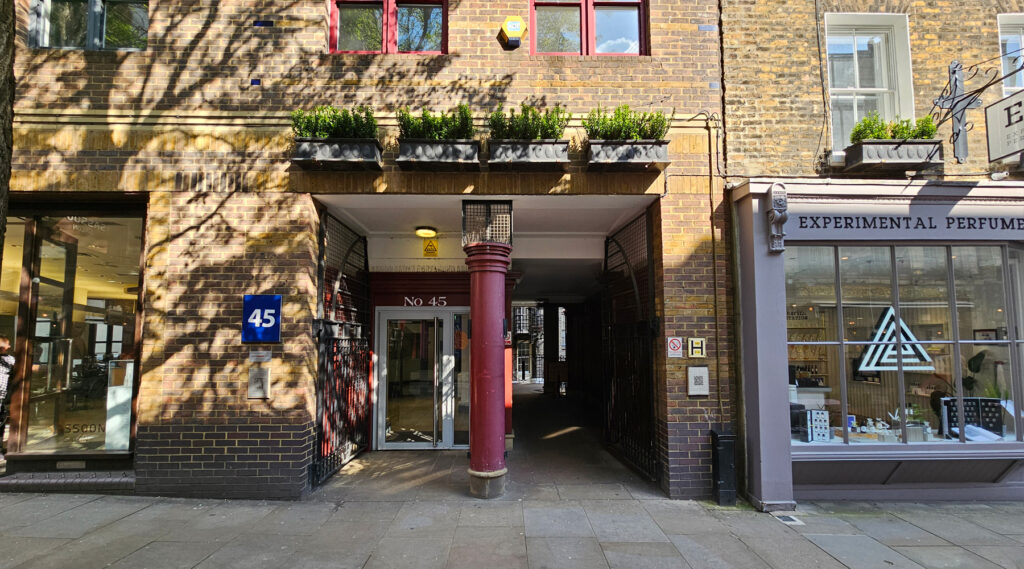Just down the road from busy Seven Dials in central London, there’s a remarkably quiet courtyard that, locals aside, hardly anyone seems to know exists. When you think how busy the area is, having a hidden oasis of tranquillity is remarkable.
The triangular courtyard sits within a triangular development that’s a mix of restored Georgian houses and post-modern development that saw a once run-down area revamped in the early 1980s.
The road layout was laid out in the 1690s, and over the centuries, saw many different uses. The most notable was a firm of ironmongers, who was to end up owning the entire block.
Comyn Ching was named after a firm that came from the merger of Cornish and Northumbrian families, and set up in the area in the 1720s. The business flourished, and seeking to expand, they started buying up neighbouring buildings and the backyards, until by the 1970s they owned the whole block, and filled in the spaces behind the shop fronts with more offices and workshops.
However, the firm moved to Holborn, and in 1978 they commissioned post-modernism guru, Sir Terry Farrell to come up with a master plan for the site.
What his firm came up with is a design that created three modern corners for the triangle, with the most obviously post-modernist corner next to Seven Dials, restored the older buildings along the three edges, and created a courtyard in the middle to bring light into the development.
The designed assemblage is said to have been inspired by Colin Rowe’s “Collage City” published during the early stage of the design and is regarded as one of the best examples in the UK of the Post Modern approach to urban design and architecture.
The modern buildings are a mix of housing and offices, while the older buildings remain shops and above-shop uses.
The development won the Civic Trust Award in 1985.
As part of the planning agreement, the courtyard would be open to the public during the daytime, although in my experience, hardly anyone knows it’s there. I’ve rarely seen more than a small handful of people using it, and that’s busy as usually I’ve been lucky to have it all to myself.
The curiosity is that while the name of the courtyard, after the ironmongery firm, Ching Court is not at all Chinese, because it sounds like it is, I can’t help seeing Chinese influences in the design of the architecture. Especially the timber frames around the doors. However, those timber frames were inspired by Charles Rennie Mackintosh’s Hill House, and aren’t Chinese at all.
And it’s especially noticeable from the, usually locked, entrance on Shelton Street, with its black lacquer and red text effects.
Fortunately, there are a number of metal plates dotted around the courtyard and by the entrance that explains a bit of the history of the area, and dispel the Chinese suggestion in the name of the courtyard.
The rest of the yard has a restrained, semi-formal air with Yorkstone paving, wall-top benches and ornamental trees in iron grilles. It slopes gently to one side to reduce the need for deep steps at the lower end, where a semi-circle of modest drops takes you to the far exit.
There’s seating along two sides of the courtyard, but not much, as it’s overlooked by residential housing as well as the offices.
The development was rightly given heritage listing in 2016.
Roger Bowdler, Director of Listing at Historic England said: “Comyn Ching Triangle represents Postmodernism at its purest and is an early, masterful exercise in placemaking by one of the country’s leading architects. It is widely seen as one of Terry Farrell’s most important works of the time where he delivered much-needed urban regeneration to Covent Garden by keeping, respecting and integrating historic buildings, rather than redeveloping the site.
Covent Garden had been saved from destruction in the 1970s by both community action and listing. Comyn Ching marks the recovery of this special area of London. It is a striking example of the emerging philosophy of conservation and regeneration, and deserves recognition through listing.”
Not only does Seven Dials have one of the UK’s best post-modernist property developments, it also has one of its quietest public courtyards.
If visiting, in my experience, the very obvious entrance on Shelton Street is rarely, if ever open, leaving the less noticeable obvious on Monmouth Street to use. But do go around the other side to take a look at the Shelton Street entrance as it’s quite marvellous to look at — if not to use.
The sign by the gates says that they should be open between 8am and 8pm.











Heads up – I was told by a resident that this closes at 6.30pm and you can be locked in without warning.